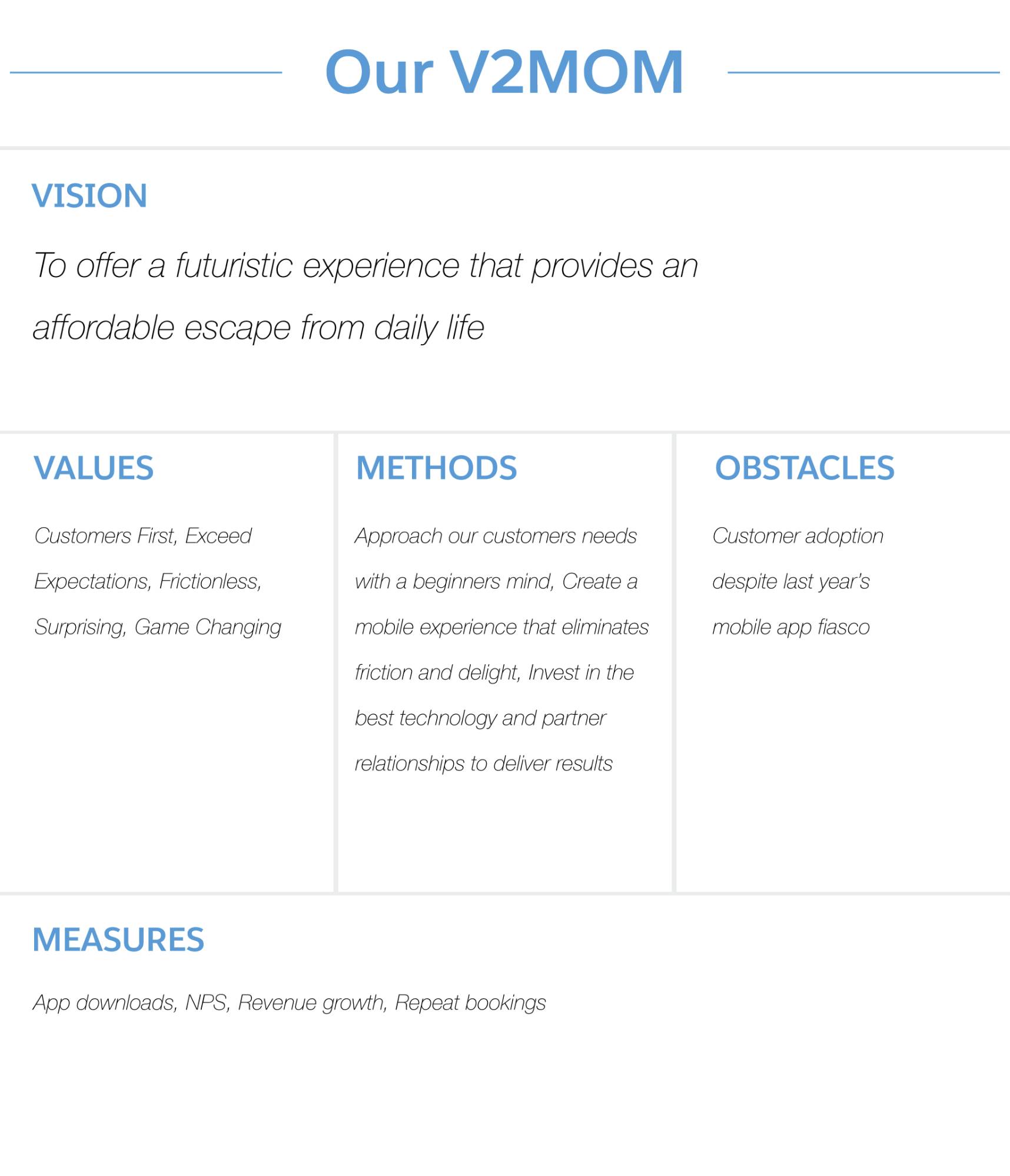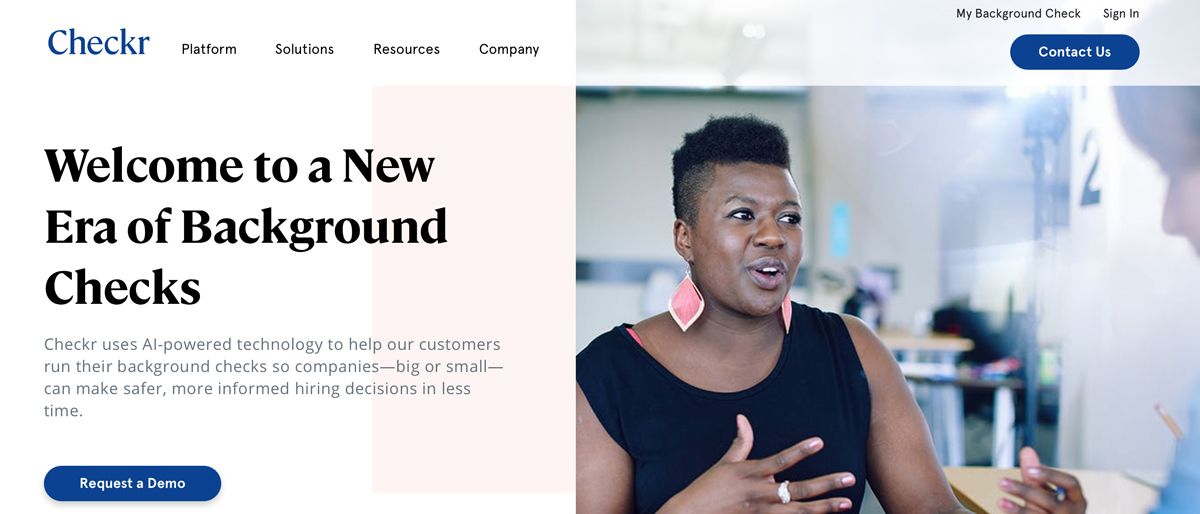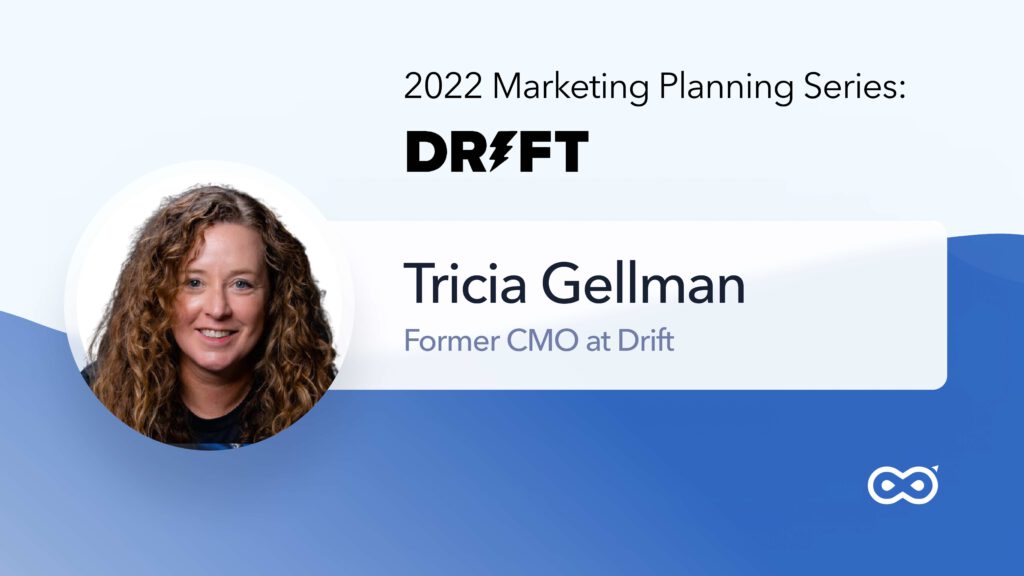Tricia Gellman, previously CMO of Drift for more than two years, has over 20 years of marketing experience. She has worked for a number of top companies, such as Apple, Adobe, and Salesforce.
Tricia orchestrated the transition of Drift’s messaging from conversational marketing to revenue acceleration, which was an extremely successful move for Drift.
During this interview, we touch on the planning strategies that drove Tricia and Drift to make that successful move. Here are the main takeaways:
- Tricia talks about adopting Salesforce’s V2MOM, a management process that stands for: Vision, Values, Methods, Obstacles, and Measures.
- She also shares how Drift switched its focus from transforming the business, which attracted mostly SMBs, to attracting enterprise businesses by focusing their messaging on revenue orientation.
- Tricia stresses the importance of alignment at the corporate level. This involves agreeing on what the company’s marketing efforts should be measured against, alignment on who you are, what you are about, and how that will help you to achieve your goals.
- The way Drift plans for revenue goals is to first align the different departments with the revenue model. This involves identifying the contribution of each team and figuring out the numbers that lead to the agreed goals being achieved.
What is your marketing planning process for 2022?
This is the very thing that we were doing at Drift before I left. In my opinion, the number one thing is to have complete agreement across the company on the goals for the year ahead. So, actually, one thing that I stole from Salesforce—but they would like everybody to do it—is what’s called the V2MOM.

V2MOM (vision, values, methods, obstacles and measures) is an alignment tool. A lot of people use Google’s OKR process, which is great because it sets very clear goals and people can easily understand the numbers.
But the V2MOM process creates a story. Every company needs to identify what it is that really matters—the thing that everybody should hang their hat on.
- Where are they trying to go?
- What is that vision?
- How do they emotionally get behind it?
- What is the story behind it?
- What are the values?
- What are the methods and who are the owners of those methods?
- And on top of that, what are the specific metrics that will be measured?
Anyone can do OKR and V2MOM. First, identify what are you about, your purpose in the company, and then what are you going to do. What are the metrics that you’re going to measure, what are you going to stand for emotionally, and then what are you going to stand up for?
The switch from SMBs toward enterprises
For example, at Drift, the idea was that we were going to transform the business. It was great that we had this amazing brand and we were doing tons of content marketing and everything else, but that was attracting SMBs.
We decided that we were going to move toward enterprises. What does that look like? At the end of the day, what Drift stood for and what Drift marketing stood for was transforming ourselves for the future of marketing.
What does the future of marketing look like? That’s what Drift, as a product, is trying to give to its clients. But it’s also what Drift, as marketers, need to be.
You can’t tell everybody to use your solution and tell them you’re going to be marketing toward the future if you’re not already demonstrating that and being an example of the future.
So that was our vision—to be an example of the future. If you’re going to be an enterprise marketer, you need to be doing these things.
That approach would then help us get to our goals, which is X amount of growth in revenue and Y amount of pipeline. Maybe one of the things we were looking at was an increase in ASP based on messaging, whatever those things might be.
That’s the first and most important thing: alignment at the corporate level on how marketing efforts are being measured, and alignment within the marketing organization on who you are, what you are about, and how that is going to help you reach your goals
How was your planning linked to revenue?
The first part of what we did, especially at the CMO marketing level, was align the operations team with the CFO and others on the model that was being built for the company. You can ask yourself the following questions to achieve this:
- How much of the revenue is coming from pipeline-generated sales?
- How much is coming from marketing?
- How much is product-led growth?
Then, you must look at that data and align on those metrics. I call these numbers the math of the business.
If you have a trial-based, product-led growth business, you may have 50% of your revenue coming from there, but then there’s 50% that needs to be driven by other things.
So, it’s about figuring out the math of where your revenue growth is coming from and then backing into that with the operations team and with sales.
You can say to them, “Okay, so if 50% is going to be coming from feeding the sales department rather than from product-led growth, then:
- What does marketing have to do to feed the sales department?
- What does sales have to do themselves?
- Do we agree that sales do anything themselves? In some places, they do, and some places, they don’t. It depends on whether you’re going after an SMB or you’re going after enterprise.”
Was it easy to prove the contribution of marketing?
I think that a key thing for the early days of a company is to identify how you are measuring the impact of marketing.
That was a problem I encountered at Checkr. They weren’t measuring anything. Everything was just coming through forms on the website.

Think about who can help you put up your tech stack and help you to begin to measure, even if it’s high level. Even if all you can do is just measure the traffic to your campaign URLs, it’s about getting something.
At Checkr, we didn’t have the tech stack build-out, and we didn’t have a functioning CR organization to follow up on leads.
So, what could we measure initially? For us, it was when we did things in LinkedIn versus Facebook versus somewhere else. Even if we went to a trade show, we could ask ourselves:
- What is the actual follow-up and the conversion?
- How many people do we touch?
- At what level are those people?
- How does it convert, even if it’s just to a meeting?
Because we didn’t have a sales leader, it was very hard to figure out if it was a good meeting or a bad meeting. Essentially, there was nobody driving the sales department. But I think the key thing is to own what you can own.
And if that’s just traffic numbers, the number of impressions, whatever it might be, then try to build the stack so that you can measure further and further down. Beyond that, you can partner with sales and sales ops so that you can actually measure the true impact.
What are some top-of-funnel KPIs that you use, and how do you manage to connect them back to revenue?
Brand is one of those things that is really difficult to measure. Something that you can measure, however, is the growth of traffic to your website, as well as—assuming you’re in the B2B space—your traffic and engagement on LinkedIn.
Those two things are really good measures of how you are growing your brand, which is more of a top-of-funnel metric.
At Drift, we also did tons of content marketing, so it was not just about the traffic to the website, but also about engagement with the content itself.
So, we created this whole other area called ‘Insider,’ where people could sign up to access content. Every single week, we monitored new signups for Insider and the growth of community membership.

Community is becoming increasingly important as the world grows ever more distracted and disconnected. It’s important to think about how we build a community and use community growth and the engagement of people within that community as a top-of-funnel metric.
What have you learned about planning from COVID?
In the SMB space, we just did lots of content, so it was really noisy. It wasn’t clear who it was for and why we were doing it. As a result, everybody was just doing their own thing.
I said, “Hey guys, we have to do integrated campaigns.”
- Which personas are we going after?
- What is our goal with them?
- Are we just trying to do Insider, which is brand building, or are we doing messaging to sales leaders? What is it exactly that we’re doing?
- How much of our budget are we going to allocate to each part?
Is it new? Going after sales leaders was really new, so we had to invest a decent amount of our budget and see a lower return rather than continuing to do Inside, distributing our content, or going after marketing leaders.
By doing that mix of prioritization, everyone knew what we were doing and why we were doing it.
Then, when COVID hit, all of a sudden, we were like, “oh shit.” Which of these things can we keep doing, and which ones do we have to change? Which messaging works, and which messaging doesn’t work?
By the end of March, we were already very clear on the changes we needed to make to our campaigns. We had asked ourselves:
- Do we need to change our messaging?
- Do we need to stop things?
- What do we need to do?
Luckily, everyone was able to align quickly on what we were doing. It was the same thing when the Black Lives Matter protests happened.
With each of the challenges we have encountered over the past two years, we were able to look at the plan and decide what we were going to do, what has priority, and what doesn’t.
Why did you scale back content?
One of the things we had to recognize was that we were trying to do too many things while people were working remotely. We had cut back.
We had to be very clear on the prioritization and make sure that we weren’t oversubscribing people. It’s just exhausting to do everything through Zoom and from home, and it may not be the best work environment for some people.
When COVID began, we were doing seven webinars a month and nine blog posts a week.
It was already way too much, and people were getting burnt out. But then when you include the fact that people are working from their dining room table, they’re having dinner and breakfast and doing everything from that spot, too, and they’re juggling their kids, it was an unsustainable approach.
Some people are single and have a great environment for remote work, which means they can overachieve. But if you factor in the team and the team dynamics, we simply had to cut back. So, we moved to a schedule of four blog posts a week, and I think we only did four or five webinars.
We almost halved everything. Because we knew the goals of the campaign, we were able to say, “Okay, maybe we just don’t have the capacity anymore to do some of these things.”
If you do your annual planning, align it correctly, and you’ve figured out your priorities with your integrated campaigns, then at any moment, you can be agile and identify whether a certain thing or issue matters or not.
And this is not just based on people’s capacity, but also on what’s happening in the market.
In the past two years, people have been way too distracted. In the past, doing webinars may have been great, but everybody’s online all the time now.
So is it still that great? What is the tactic that you’re going to use? Maybe you have to change your approach to make it impactful for the times we are in.
Do you use forecasting for budget planning?
I think forecasting is a more advanced thing for budgeting. First of all, most marketers are terrible at managing their budget.
And secondly, we talked about having an op stack and tech stack to actually measure the impact of your marketing efforts. Ideally, depending on the size of your company and how established you are, you start by signing up to measure something, whether it’s your web traffic or whatever it is, and then you build out the stack.
That way, you’re actually measuring from the channels which things matter and which things are driving revenue. You can also layer on top of that the ROI with your budget. That’s where you want to be. You need to know that when you spend money in X area, it gives you Y return.
I would love to have all that in place from day one, but it’s not realistic for most people.
How do you develop a feedback loop to know what’s working and what’s not, especially given the long sales cycle?
At Drift, we were still doing business with companies with 50 and above employees. This includes SMB, mid-market, and enterprise companies.
It’s mixed, so, essentially, you have to do everything.
Even for enterprises, you have to have air covers. You have to figure out how much of your budget you’re going to put toward the brand, which just means making sure that there’s enough noise and message being put out into the market.
You also need to look at the mix of what you’re doing. Even if you want to be a revenue-focused marketer, you probably have to leave the revenue numbers specifically to your sales department, and you need to sign marketing up for the pipeline because that’s closer to what you can actually impact.
And then on the longer sales cycles, you can see:
- How long does it take to complete the sale cycle from the action you take?
- How many touches do you have to do?
- How many people in the company do you have available to do these touches?
- Is it a buying committee?
- And then how are you making progress?
I’m a big proponent of the marketing funnel, which is not your typical funnel. If you look in Salesforce at what sales are doing, they have stages.
Approximately 50% of the businesses are in stage two, and then it moves down to stage seven, let’s say, before business is closed. Marketing can do the same thing.
And you can actually look at all of the people who are in your funnel. This allows you to identify which people you have touched multiple times and which companies have multiple stakeholders in the same company.
Especially in B2B, most companies are now moving to some level of ABM, where you’re not going after the whole universe. With enterprise companies, you’re going after a certain number of accounts.
You can say, “Okay, we have 14,000 accounts that we’re going after.” Of those 14,000, you can decide that stage zero means we haven’t touched anybody. Nobody’s engaging with us. But stage four means we have two people. They’ve touched two things.
Even if you don’t have a sophisticated MarTech stack, you can say, “Okay, for the deals that are closing, how many people did we talk about, and how many times did they touch marketing—even if it’s just touching different web pages?”
In order for a deal to become an actual pipeline, we need to have somewhere between seven and 12 touches.
Takeaways
Tricia shared many insights into what drives her marketing planning. From the V2MOM process, adopting an agile strategy post-COVID, and her decision to scale back content.
With Drift, Tricia took a successful brand and organized it around new priorities, new messaging, and a new target audience.
This was no easy feat, and there is a lot to learn about marketing strategy from how Tricia managed to work it out.

